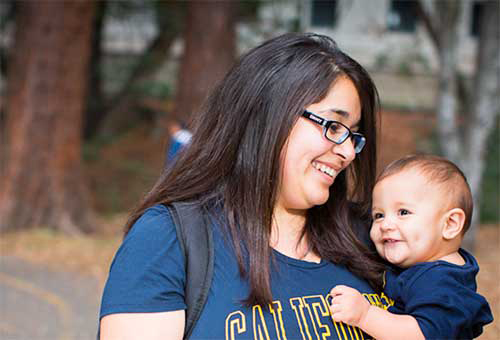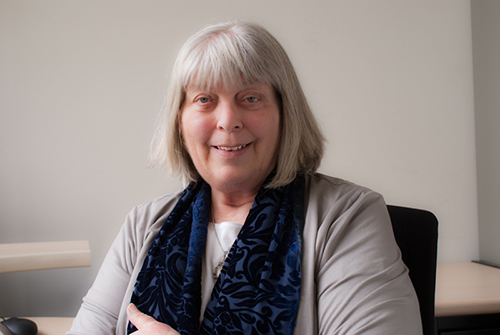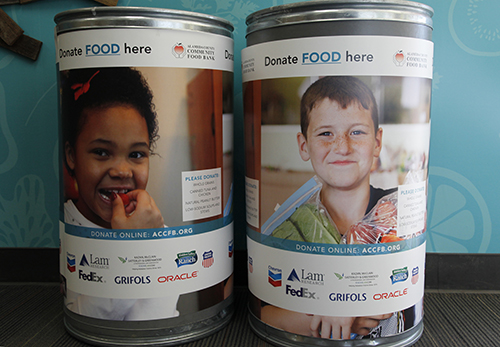Holiday help wanted: Meals for students
Faculty, staff and students can help alleviate food insecurity

November 30, 2016
Back by popular demand, the year-old Cal Nourish program is again asking faculty and staff members to donate gift cards from local markets to help many among the estimated 800 Berkeley students who will struggle to buy food during the winter holiday break.
Last year, the UC Berkeley Human Resources program hoped to assist 150 students. But in just two weeks, Cal Nourish collected more than $9,000 in gift cards, enough to provide groceries to 300.
“We didn’t know what to expect last year, and we didn’t expect within 48 hours that the cards would be gone,” says Fabrizio Mejia, assistant vice chancellor for student equity and success. “It told me the need is great, the need is there.”

American Studies major Esperanza Campos, holding son Mauricio Ferrer, says the Cal Nourish gift cards “make a lot of difference” to student parents. (Residential and Student Service Programs photo)
This year, Cal Nourish is “raising the bar, and our starting goal is to help at least 300 students before they complete their finals in December,” says Jeannine Raymond, assistant vice chancellor for human resources. “The generosity we saw last year is a true reflection of the compassion and community that faculty and staff embody at Berkeley.”
Leadership at the Centers for Educational Equity and Excellence (CE3) will distribute the Cal Nourish gift cards on a first-come, first-served basis to:
- Students who are current or former foster youth
- Students who are parents
- Pell Grant and Dream Aid students
- Other students, depending on the availability of cards and demonstrated need
By Monday, Dec. 12, Raymond asks that gift cards in amounts between $20 and $50 from these markets — Andronico’s, Berkeley Bowl, Safeway, Target, Trader Joe’s or Whole Foods — be delivered to any of several campus offices:
- North side of campus – Room 101 Giannini Hall, College of Natural Resources
- East side of campus – Almadora Henry, front desk, dean’s office, 545 Student Services Building, Haas School of Business
- South side of campus – Trisha Milazzo, 201 Boalt Hall, Berkeley Law
- West side of campus – Main reception desk, Room 192, Human Resources, University Hall
- Campus Shared Services – Pam Lyons, cubicle No. 301-13, 1608 4th Street, Berkeley
Gift cards should be placed in an envelope with the name and email address of the individual giver or department on the outside. They will be distributed to students on Dec. 13 and 14.
Sustenance for winter break
According to the latest UC Undergraduate Experience Survey, 39 percent of Berkeley undergraduates lack consistent access to nutritious foods. In the 2016 UC Graduate Well-Being Survey, 23 percent of Berkeley graduate students fared the same.
From mid-December to mid-January, “students have a deeper need for food security because their financial aid packages don’t cover time that is not considered (part of) the instruction periods they are enrolled in,” explains Mejia. “Many are going home, if they have a home, to a family or a support system that has little means to feed another mouth.”

The UC Berkeley Food Pantry is seeing triple the visits it did before moving to the ASUC MLK Jr. Student Union. (UC Berkeley Food Pantry photo)
Last year, students used their gift cards from the campus community “and bought a week’s worth of groceries,” he adds, “and it sustained them at a time when they wouldn’t have had anything. It was also helpful for students to understand that faculty and staff support them. They were surprised and thankful.”
At the Student Parent Center, director Ginelle Perez says that “at this point in the semester, student parents can be really, really low on funds” and have to survive the winter break without financial aid and with the added expenses of the holidays and warm clothes for their children. “These cards validate their experience,” she adds, “and let them know they’re not alone, that they have the support of the campus.”
Perez says that last year, in just a half a day’s time, 109 student parents signed up to receive the limited number of gifts cards.
Student parent Esperanza Campos, a senior who lives in University Village, says a Cal Nourish gift card last winter helped her following surgery, when she required bed rest and couldn’t take enough classes for a while to be eligible for financial aid. “If someone is hungry,” she adds, “$20 to $50 can make a lot of difference” and also provides a cushion when the unexpected happens.

Jeannine Raymond, associate vice chancellor for human resources, helped launch Cal Nourish in 2015. (Central Human Resources photo)
Raymond, who is retiring next month after 10 years on campus, says she first realized three years ago that, as the holidays approached, the campus needed to think of ways to be generous not only to the surrounding community, but to its own students.
“This program has meant a lot to me, and I was glad I could start it,” she says. “It can only survive if there are people who are equally interested to carry it on and will help those in my office who share that interest.”
Points for the pantry
Another campus program, I Love the Food Pantry, is asking students for help this season. Students can use their unused dining hall meal points to help buy groceries for the UC Berkeley Food Pantry in the ASUC MLK Jr. Student Union. Anyone can contribute to the pantry throughout the year by volunteering time or funds.
In a departure from last year, students can donate as many points as they want, says Samantha Lubow, Cal Dining’s environment initiatives coordinator. A maximum of 20 points was allowed in 2015-16.
Cal Dining uses the food cost value of the combined meal points to purchase groceries needed and approved by the food pantry. For the past three years, she says, the meal point program and Cal Dining’s team has helped keep the UC Berkeley Food Pantry stocked.

In 2015-16, donations of unused dining hall meal points provided over half the funding the pantry needed for the whole year. (UC Berkeley photo by Hulda Nelson)
Students can donate their meal points to the I Love the Food Pantry program through Friday, Dec. 16, by stopping by any one of these Cal Dining retail locations — the Golden Bear Café, The Den (next to Crossroads dining hall), Cub Market (next to Foothill dining commons), Bear Market (near Café 3) and CKCub on the Clark Kerr campus.
“This year, the pantry is serving triple the number of students that it did during the past two years. So, both Cal Nourish and I Love the Food Pantry are essential programs at Berkeley,” says Ruben E. Canedo, chair of the campus’s Basic Needs Security Committee. “Donations of unused meal points last year in the fall and spring provided over half the funding that the pantry needed for the whole year.”
In November 2016 alone, he adds, the pantry was visited more than 670 times, compared with 220 visits the same month last year. Canedo cites increased campus awareness of the pantry and its move from Stiles Hall to the more central, bustling ASUC MLK Jr. Student Union as factors in the jump in usage.
County food bank drive continues
Meanwhile, non-perishable food is being collected across campus in barrels provided by the Alameda County Community Food Bank, which serves one in five county residents, nearly half of them children. Empty barrels are provided to offices and units by the food bank upon request.
But since receiving an empty barrel during this point in the season can take up to two weeks, Katherine Avila, the food bank’s food drive coordinator, says campus offices, units, departments and schools should consider taking part in the virtual food drive.

Alameda County Community Food Bank barrels need filling year round. (Photo courtesy of Alameda County Community Food Bank)
“It’s a very safe and secure way to donate,” she says, “and for every $1 donated, we get $5 worth of purchasing power for our most needed items, which can’t be always be placed in a barrel — produce, milk, eggs and other protein products.”
The virtual food drive also saves the food bank resources including schedulers, drivers, food sorters and fuel.
Avila stressed that while there’s never a bad month to host a food drive, it’s most impactful to help the Alameda County Community Food Bank at other times of the year, “when holiday spirits are in the rear-view mirror.”